
Tarte au citron is a classic of French cuisine. You can find lemon tarts everywhere in France, from the elegantly designed displays of elite pâtisseries to humble bistros, as well as in the home. Tarte au citron can be dressed for any occasion: topped with whipped cream or fruit, decorated with Italian meringue and toasted in the broiler (meringuée), or simply dusted with confectioner’s sugar (nature). However you serve it, it’s a bright, zesty tart sure to add some zing to your day.
The History of Tarte au Citron
Ubiquitous across France today, the history of tarte au citron is much harder to find. Lemons were introduced to the Roman Empire during the second century AD. Lemons were also widely cultivated in the Arab world and were brought to Europe through Al-Andalus, the name of the Iberian peninsula under muslim rule from 711-1492. This helps explain the two roots for the word lemon in various European languages; citron being based on Latin origins and lemon from the Arabic limun. During the Age of Exploration, the Spanish brought lemon seeds to the Americas. In addition to geographical expansion, lemon’s culinary uses also expanded when it was discovered by James Lind in the mid-1700s that lemon could help seamen suffering from scurvy.
Fruit curds are credited to England in the 19th century. The original lemon curd was much different from what we have today. The acid in lemon juice was used to form curds in cream and then separated from the whey in a cheesecloth, hence an alternative name, fruit cheese. Modern lemon curd probably evolved from “transparent pudding” in the Victorian era, essentially a custard of thickened butter, sugar and eggs. Lemon curd became a popular alternative to jam to spread on toast or scones.
Tarte au citron’s popularity in France also begins in the 19th century. This is when the tart dessert began to proliferate pâtisseries and restaurants all around France. And now let’s examine a quote I found on nearly every recipe for French lemon tart: “La tarte au citron était servie au roi au début du XIXe siècle. Elle était symbole de richesse et de bonté.” Or, “Lemon tart was so revered that it was served to the king at the start of the 19th century as a symbol of wealth and goodness.” But let’s consider this quote in the context of France’s history: the French Revolution.
The 19th century was a complicated time for government in France. The French Revolution began in 1789 and ended in 1799, establishing the First Republic which lasted from 1792 to 1804. Not to mention, it would have been impossible for Louis XVI to enjoy a slice of tarte au citron as he was beheaded in 1793. The First Republic was succeeded by the First Empire under Napoleon. Following Napoleon I, King Louis XVIII briefly ruled France from 1814 to 1824. So, it is possible that the quote refers to King Louis XVIII, convincingly nicknamed le Désiré, the Desired. Though I have not been able to find any source for the quote or story about King Louis XVIII being served tarte au citron. If you happen to know, or find it, please let me know in the comments.
How to Make Tarte au Citron
- It starts with a base of pâte sucrée, or sweet tart dough. The recipe here is from Pierre Hermé, an acclaimed pastry chef in Paris. The crust is rich with butter, perfectly crisp, and easy to work with.
- Contrary to pie dough, this pâte sucrée starts by creaming the butter, sugar and egg and then adding in the flour. Try not to overwork the dough when mixing, as it can result in a tough tart shell that shrinks when baked.
- When rolling out the dough, make sure it is thoroughly chilled. As the dough warms up, it will begin to stick to the work surface.
- The crème au citron, or lemon curd, is pretty straightforward. This version is pretty sharp with lemon. If you prefer, you could use less zest or increase the sugar to 200g (1 cup).
- Heating over a bain-marie is not strictly necessary, it can be done in a thick-bottomed sauce pan on the stove. A bain-marie reduces the heat transfer and helps to prevent overheating and cooking the eggs.
- If the mixture isn’t as smooth as you’d like, you can pass it through a fine-mesh sieve before filling the tart shell.
- A short bake in the oven allows the lemon curd to settle into the shell and set a bit.
- Be sure to at least let the tart cool completely before slicing, and it’s really at its best after chilling in the refrigerator for a few hours.
Looking for more French recipes?
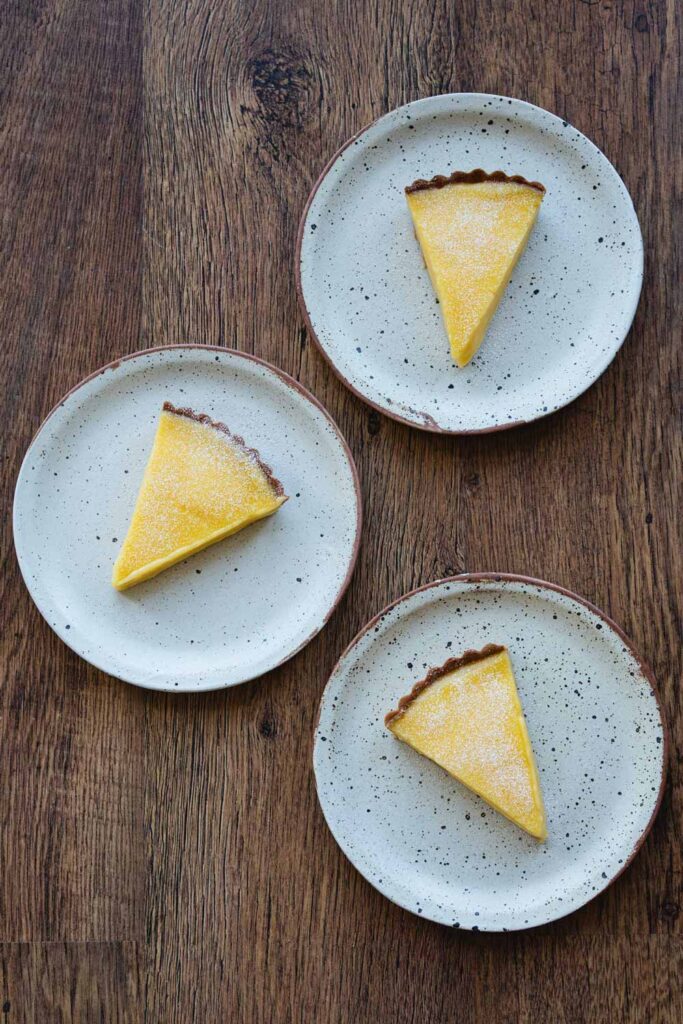
Ingredients:
Pâte Sucrée: Sweet Tart Dough
Yields 2 9-inch (23cm) tart shells.
75g icing sugar
1 large egg, room temperature
25g almond flour
1/4 teaspoon salt
250g plain flour
2/3 cup powdered sugar
1 large egg, room temperature
1/4 cup almond flour
1/4 teaspoon salt
2 cups all-purpose flour
Crème au Citron
Yields 1 9-inch (23cm) tart.
150g granulated sugar
4 large eggs, room temperature
4 large egg yolks, room temperature
225ml lemon juice
170g unsalted butter, room temperature
3/4 cup granulated sugar
4 large eggs, room temperature
4 large egg yolks, room temperature
3/4 cup plus 3 Tablespoons lemon juice
3/4 cup unsalted butter, room temperature
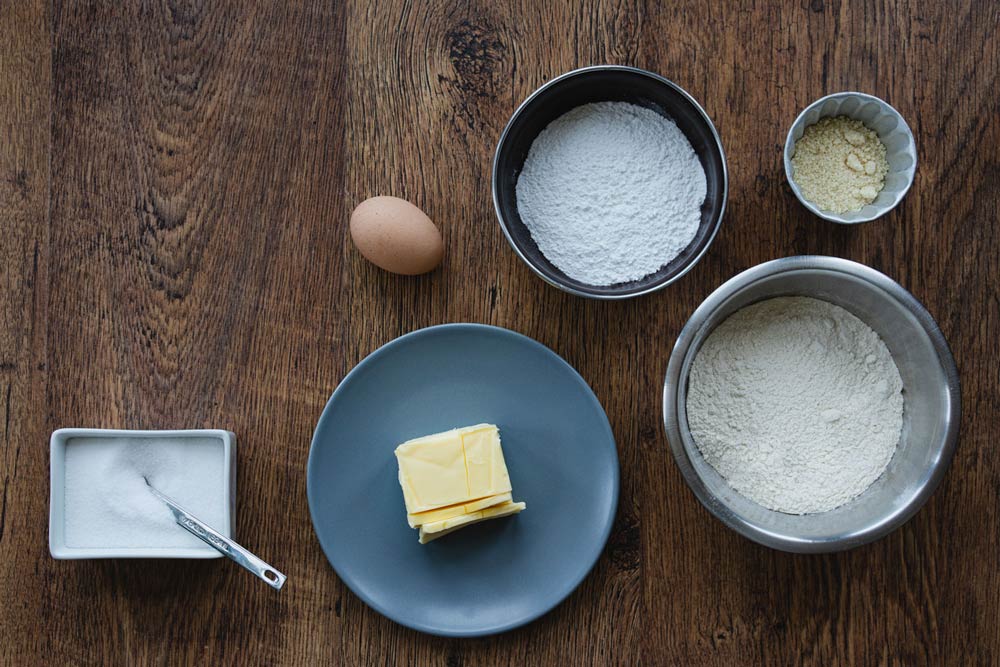
Pâte Sucrée: Sweet Tart Dough
1. Combine the butter and sugar:
In the bowl of a stand mixer with the paddle attachment, or in a large bowl with a rubber spatula, combine the butter and confectioners’ sugar and mix until smooth.
2. Add the egg, almond flour and salt:
Add the egg, almond flour and salt to the butter mixture and mix until combined.
3. Add the flour:
Add the flour all at once and mix on low speed just until incorporated. The dough should just come together into a ball. As soon as it does, stop mixing or the pastry will lose its delicate short texture.
4. Divide:
Divide the dough into two equal discs and wrap in plastic wrap.
5. Rest and chill:
Set the dough in the fridge and leave to rest for at least 2 hours, or overnight.
6. Roll out the dough:
Try to work quickly to prevent the dough from becoming warm. As it warms up it sticks easier and can become hard to work with.
Unwrap the dough, dust it with flour, and place it on a lightly floured surface. Roll to 1/8 inch (3-4mm) thick, rolling from the center outward in all directions. Lift and rotate a bit after every few strokes and dust with flour as needed to discourage sticking.
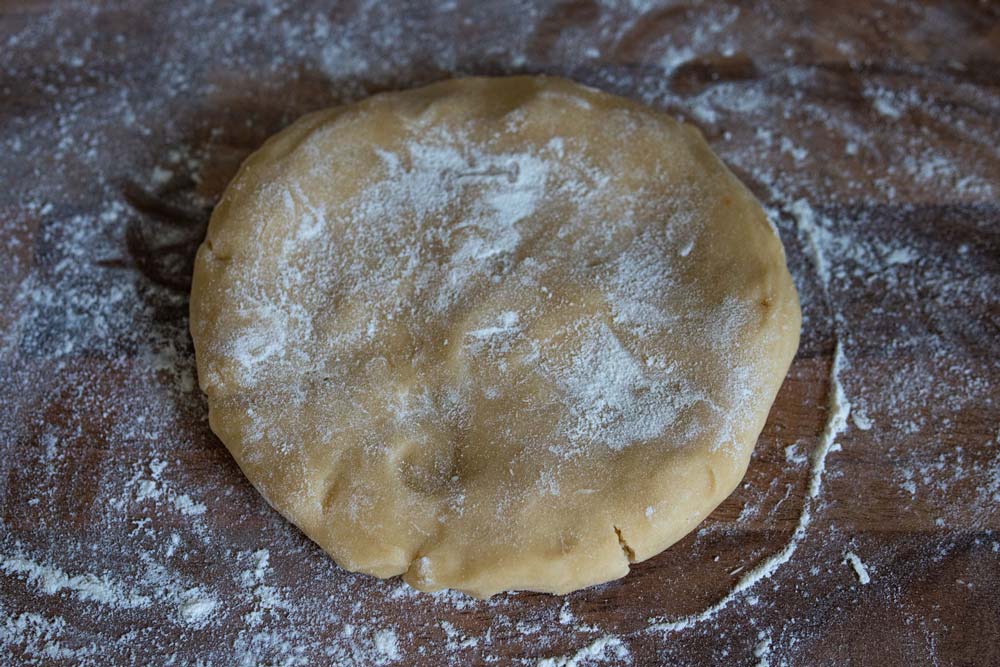
7. Line the tart shell:
Carefully transfer the dough into the tart pan. Gently press the dough into place without stretching the dough or the sides will shrink while it bakes. Roll the rolling pin over the top to trim the edges. Prick the base all over with a fork and place in the refrigerator or freezer for 30 minutes.
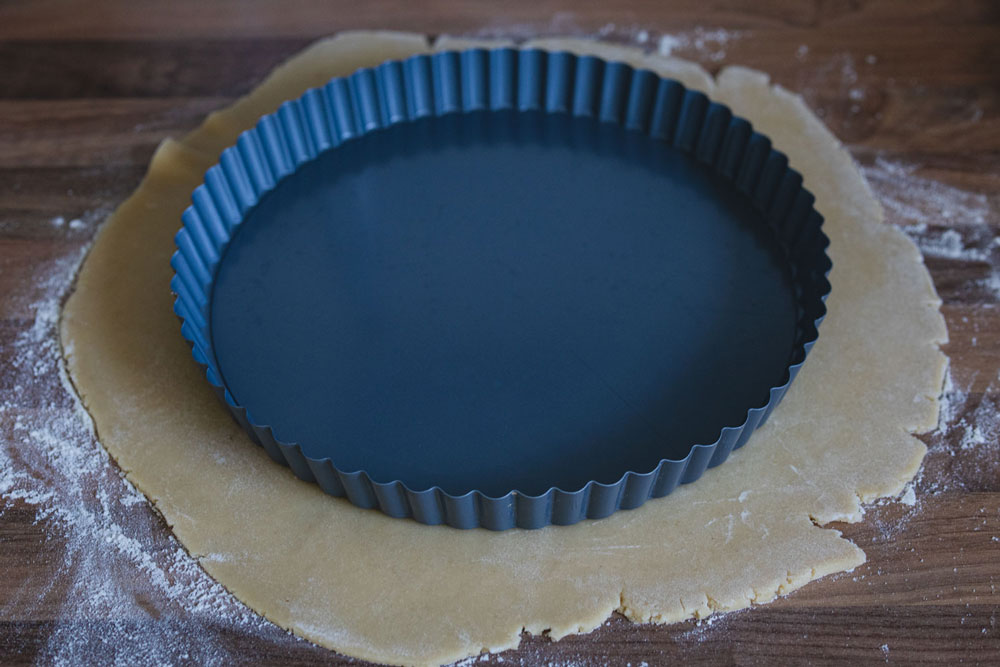
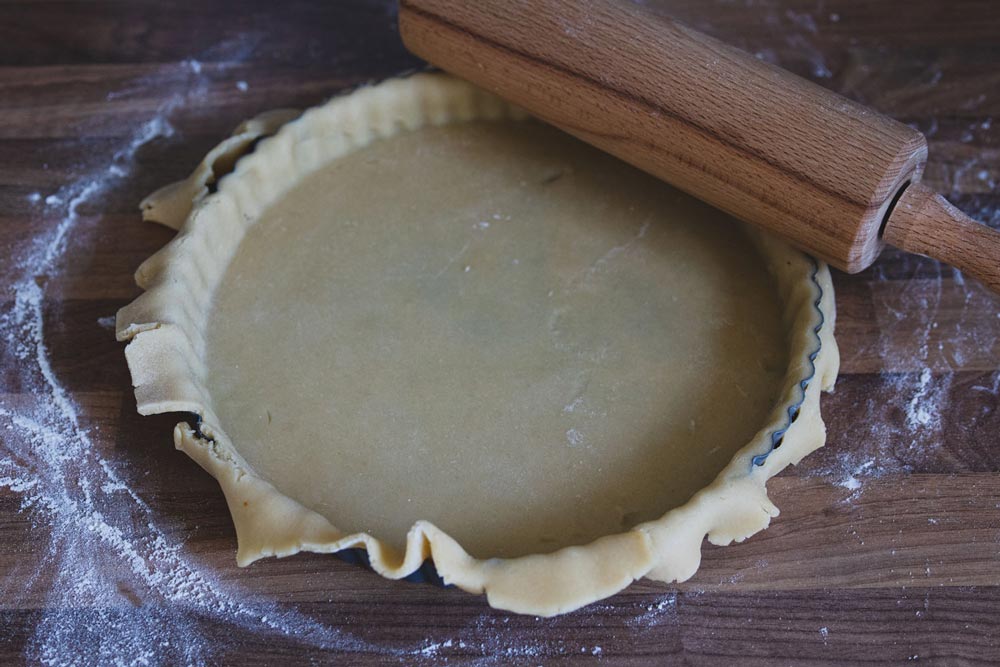
8. Bake the shell:
While the tart shell chills in the fridge, preheat the oven to 180°C (350°F).
Line the tart shell with parchment and fill with pie weights, beans or rice. Bake for 18-20 minutes for a partially baked shell.
Remove the parchment and pie weights and bake for a further 6-7 minutes for a fully baked shell. The pastry should be golden brown.
If the filling for tart is a wet filling, you may want to brush with an egg wash to seal the shell. This will help to keep the crust crisp longer. A couple minutes before the shell reaches the desired color, brush the base and sides of the shell with beaten egg before returning to the oven until golden and the glaze has set.
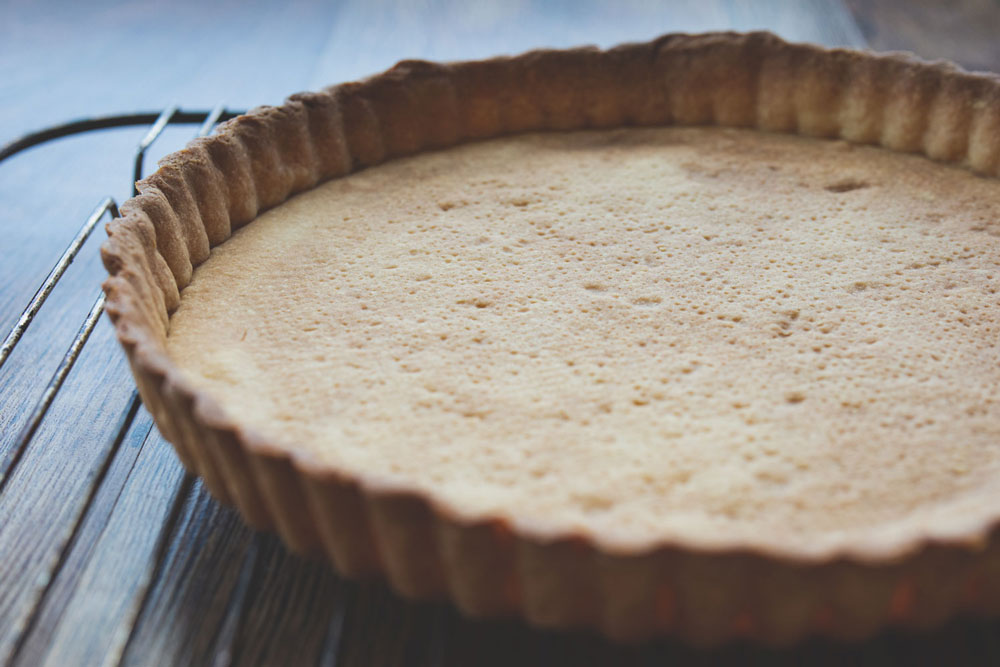
Crème au Citron
1. Preheat the oven:
Preheat the oven to 180°C (350°F).
2. Set up a bain-marie:
You’ll need a large, heat-proof bowl and a pan filled with water. The bowl should fit the pan such that it can be placed without touching the water inside the pan.
3. Infuse sugar with lemon zest:
In the large heat-proof bowl, combine the sugar and lemon zest. Using your fingers, rub the zest into the sugar, infusing the sugar with the oils from the lemon zest.
4. Whisk in eggs and lemon juice:
Whisk in the eggs, egg yolks and lemon juice and set the bowl over a pot of simmering hot water.
5. Whisk in the butter:
With the lemon mixture in the bain-marie, stir in the butter until it melts.
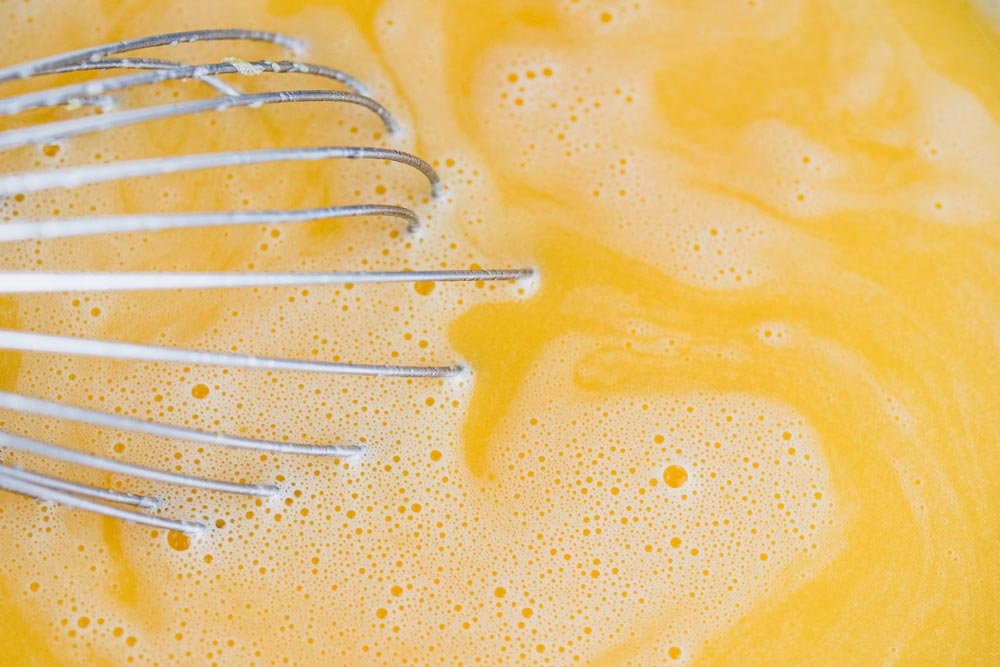
6. Thicken the lemon cream:
Keep whisking the mixture until it thickens and it holds its shape when you lift some of it with the whisk. This will take about 10 minutes. If you have a cooking thermometer, the lemon curd is cooked when it reaches 75°C (170°F). Try not to heat it past 80°C (175°F) or it might curdle. Once it’s thickened, pass it through a fine-mesh sieve if you want the filling to be extra smooth.
7. Bake the tart:
Fill the tart shell with the lemon cream and smooth the top with a spatula. Bake in the oven at 180°C (350°F) for about 5-6 minutes.
Let the tart cool completely before slicing and serving. The lemon cream will set as the tart cools.
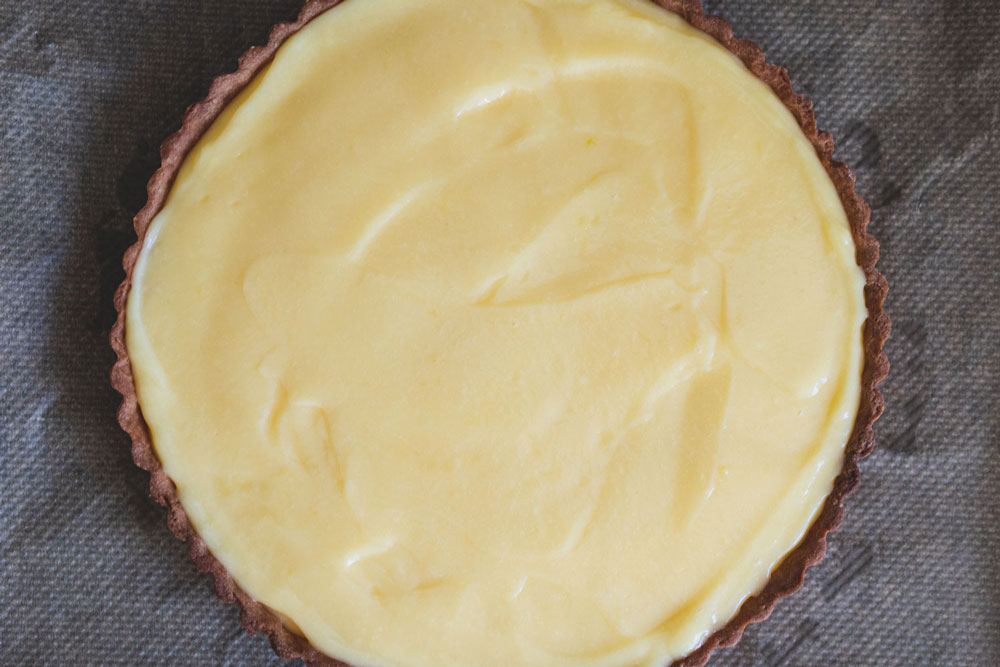

No Comments